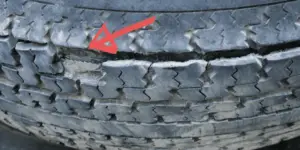Right up there with the ability to stop your car is the ability to steer it easily. When your steering wheel is hard to turn, it causes stress over safety concerns along with worries about the cost of it too.
There are four easy and quite cheap fixes and two more expensive – yet thankfully rare causes too.
In order of likelihood
- Tyre Pressure Low
- Leaking Power Steering Fluid
- Old Power Steering Fluid
- Worn Serpentine Belt
- Defective Power Steering Pump
- Bad Steering Rack
Let’s look into each one in more detail:
Tyre Pressure:
When the tire pressure is low, more surface area of the tire comes in contact with the road, which causes the sidewalls to lose their original structure and give rise to excessive friction. This friction leads to wear on the tires, and the steering becomes heavy.
Likewise, if the pressure is not the same in all tires, especially in front tires, it can be more difficult to turn in the direction of the tire with low pressure.
A nice simple fix. Sometimes when the tire pressure is really low, you’ll see that it is.
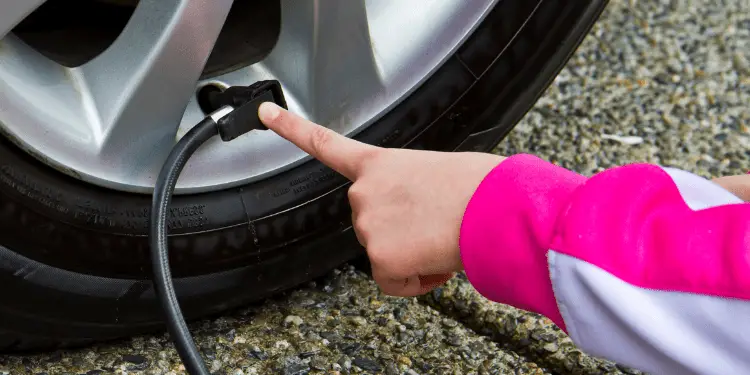
However, I’ve driven on a tire with less than 15 psi (it should have been 28 psi) and never noticed. Always best to get a gauge to check to make sure.
If the tire isn’t pumped up, it will start to wear on the outer wall, and the suspension – on that side – will be put under increased strain and can fail before its time.
Power Steering Fluid Leakage:
Power steering fluid flows through a closed hydraulic circuit, increasing the power available when turning the steering wheel.
Not only that, but the fluid also helps in the lubrication of the steering system’s moving parts, which reduces overheating and corrosion.
Power steering fluid is red, so you have a leak if you see red liquid on the road or your garage floor.
This leak is temporarily fixed by refiling the fluid in the reservoir tank. You can usually find the reservoir on the passenger side under the hood. It’ll have Power Steering Fluid written on the lid and a Max and Min line on the reservoir itself.
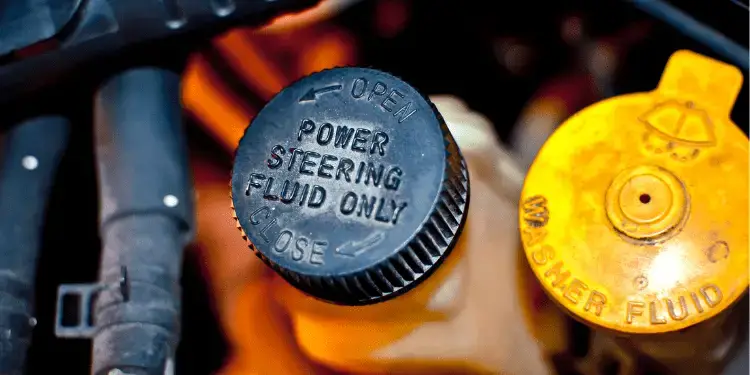
The car will be drivable for a short period, but the leak needs to be found. The hard turning and stiff steering wheel will only worsen unless you top up the steering fluid.
Power steering doesn’t evaporate, so there is a leak to blame if the level has reduced.
You shouldn’t just top up as if there is a leak; the air is replacing the fluid in the pipes and can cause air pockets to accumulate and reduce the effectiveness of the whole system.
Thick Power Steering Fluid:
Power steering fluid becomes thick and needs to be changed every 75,000 to 80,000 miles. This figure does depend on the manufacturer’s guidelines – so it’s best to check to be sure.
Power steering fluid is made from either mineral oil or silicone – with additives. These additives will separate over time and cause the fluid to thicken.
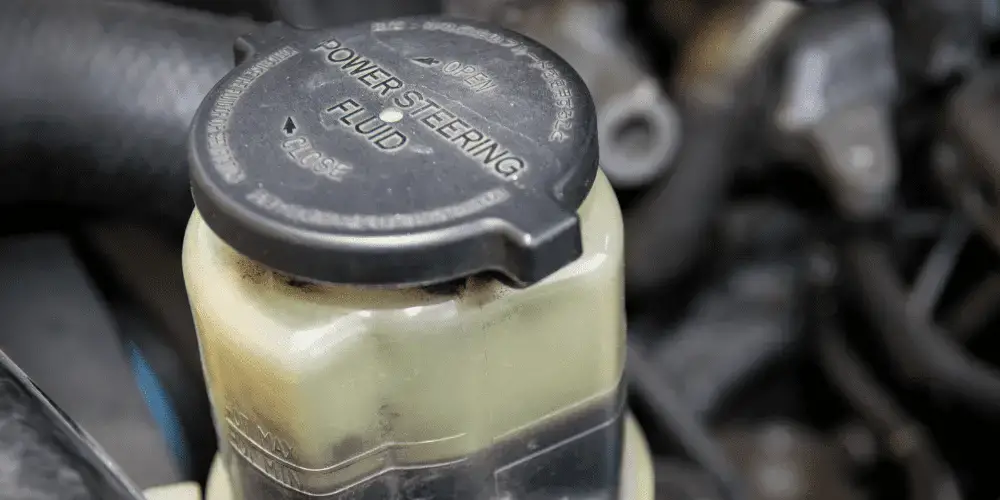
Power steering fluid is red but turns brown or black when it goes bad and needs changing. Look inside the reservoir and see what color your car’s fluid is. Poor quality steering fluid will make turning the steering wheel harder and is an easy task to put right.
Damaged Serpentine Belt:
The fourth cause is a broken or damaged serpentine belt. This belt is a vital component within the engine and is responsible for operating the power steering pump.
The serpentine belt – also known as the drive belt – also runs other systems like the alternator, water pump, and air conditioning compressor.
It often makes a screeching noise when it’s loose or even a slapping noise when the tensioner or pulley is defective. You’ll have noticed other parts not working well. A worn belt will make the steering wheel stiffer and more difficult to turn.
If the water pump is affected, your car may show signs of overheating. A hot cabin – due to the aircon compressor not receiving the energy it needs, or the car may be hard to start in the morning due to the alternator not charging the battery well enough when the car is being driven.
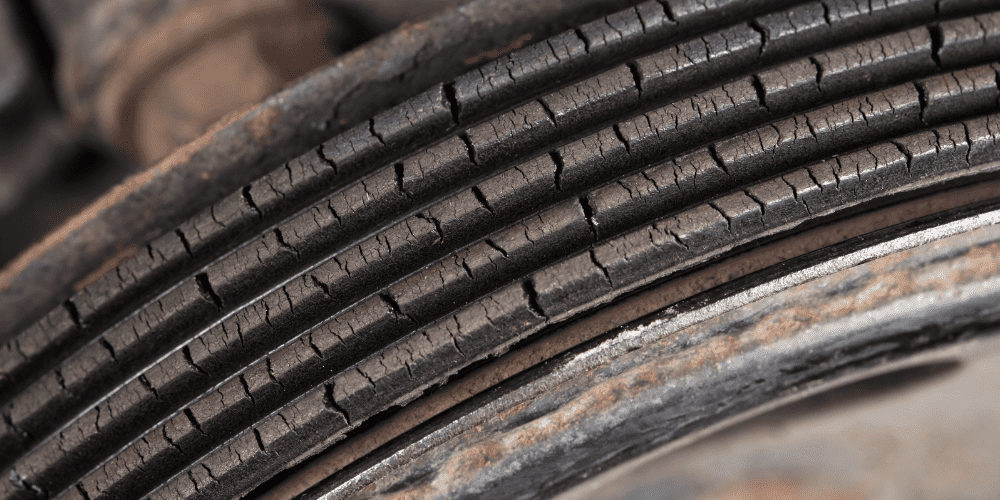
The belt usually lasts for 75,000 -90,000 miles, but being rubber, it will wear more quickly in extreme weather conditions, whether hot or cold climates.
Most car manufacturers stipulate that they should be replaced during a major maintenance service at around 80,000 miles.
A serpentine belt is a cheap replacement. It’s a rubber belt, after all.
Expect to pay no more than $30 for the part and an additional $75 – $125 for labor.
This is a simple job for a competent DIY mechanic. This video shows the process in a lot more detail.
Steering Pump Failure:
The steering pump’s role is to provide the required amount of pressure in the system so that the steering wheel can drive straight and turn quickly with minimal effort. – You should be able to turn left or right by using just one finger on the steering wheel. When the power steering pump fails, the steering wheel becomes extremely tough to turn especially at low speeds.
Power steering pumps do not have a defined life – most manufacturers state their pumps should last 80,000 – 100,000 miles, but driving environments play a big part in how long a pump will last. This is true of many other car parts too.
A car driven on urban or city roads will turn more per 100 miles than a car usually driven on a highway. More turns mean more pump usage and quicker wear.
A defective pump will not lock the car’s steering but will require more force to turn the steering wheel.
A telltale sign that the pump is going bad is a squealing noise when the steering wheel is turned sharply in both directions – not just one. The noise should stop when you straighten the wheels again.
A new power steering replacement part costs between $125 and $500. If you employ a mechanic to change its costs, labor costs are between $100 and $175.
Bad Steering Rack:
Your car’s steering rack is a solid framework that links your steering wheel to the front wheels. It uses U joints and a pinion – a small gear – at the end of the steering column that engages the steering rack when the steering wheel is turned. The steering wheel becomes stiff and unresponsive when the steering rack is faulty.
Other common indicators of a bad steering rack are:
- Vague steering at higher speeds and the car feeling like it wants to wander left or right – not to be confused with a sharper wander that normally indicates the wheel alignment needs adjusting.
- Grinding noise when steering left or right – this is the pinion gear struggling to engage correctly.
- A knocking noise – clunking noise – at low-speed turning maneuvers.
It’s difficult to estimate the cost of having a steering rack fixed, as a total replacement may not be needed. It could be something as simple as replacing the bushes.
Bushes cushion the movement between two different parts within the steering rack, costing only $5 to $25 + labor costs.
However, a complete steering rack replacement will cost between $500 and $750, plus labor costs of $200 – $350. Expect to pay between $700 and $1000 in total.
In Conclusion
Insufficient power steering fluid is the most frequent cause of a stiff steering wheel. This problem can occur if fluid leaks from the hydraulic hoses or power steering pump. The issue will be temporarily repaired by refilling the power steering reservoir, but the leak must still be resolved.





